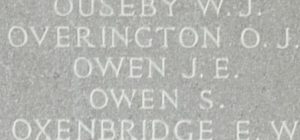Capel Curig is a village situated in the ancient county of Caernarfonshire, and lies in the heart of Snowdonia, on the river Llugwy, at the junction of the A5 road from Bangor and Bethesda to Betws-y-Coed with the A4086 road from Caernarfon, Llanberis, Pen-y-Pass and Pen-y-Gwryd. The village takes its name from the ancient Church, which is dedicated to Saint Julitta. Outside the Church lies the village war memorial, in the form of a Celtic Cross, which commemorates six local men who died during the First World War. On the sides of the base are engraved the names of the local men who served and returned home during the First World War. The names of two men who fell during the Second World War were later additions to the base of the war memorial. I have added the details of other local men who are omitted from the memorial, even though they were from the village.
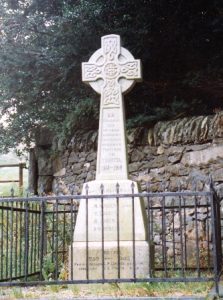
The Great War, 1914-1918
David Jones Davies, Private, 16053, Welsh Regiment. David was born in 1888, the son of Edmund Davies and Ann Jane Davies (nee Jones), of Adwy’r Wen, Capel Curig. His father was schoolmaster in Capel Curig School, but sadly died when David was young, so his mother moved with her children back to live with her mother at Tan Lan, Bethesda. David was working as a horseman at Cororion Farm, Llandegai by 1911, but soon after that moved to the South Wales valleys to find work as a coalminer. He enlisted into the 10th Battalion, Welsh Regiment at Ferndale soon after the outbreak of war. The battalion was known as the 1st Rhondda, and was raised in the Rhondda Valley by David Watts Morgan, M.P. in September 1914. Initially the battalion moved to Codford St. Mary to join 76 Brigade, 25th Division, but at the end of September 1914 moved to Rhyl to join the other locally raised units in 129 Brigade, 43rd (Welsh) Division. On 29 April 1915 the formation became renumbered to 114 Brigade, 38th (Welsh) Division, before moving to Winchester in the summer of 1915 to complete its training. The Division moved to France on 2 December 1915 and moved to the Nursery Sector near Fleurbaix for trench initiation alongside the Guards Division. Over the coming months the division held various places in the line between Fleurbaix and Cuinchy, as the men acclimatised themselves to trench warfare. On 3 June 1916 the 10th Welsh relieved the 13th Welsh, their sister battalion, in the front line near Laventie, to begin a routine tour in the trenches. On the following day the battalion sent out a raiding party, with orders to: (1) kill Germans; (2) take prisoners; and (3) to obtain information. David was killed in action during the raid that day. The body of the 27-year-old was recovered, and he was buried in Rue-Du-Bacquerot (13th London) Graveyard, Laventie, France. David is commemorated on war memorials at Bangor and Bethesda but is not commemorated at the place of his birth, on the Capel Curig war memorial.
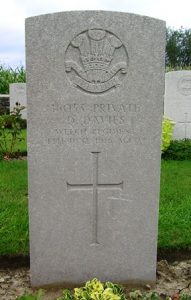
Hugh Owen Griffiths, Private, 265870, Royal Welsh Fusiliers. Hugh was born at Llanberis in 1886, the son of Owen Griffiths and Catherine Griffiths (nee Williams). He married Barbara Pritchard of Capel Curig in 1911 and the couple set up home at Bron-y-Wyddfa, Nant Peris, where Hugh worked as a slate maker. Hugh enlisted into the 6th Battalion, Royal Welsh Fusiliers at Carnarvon on 7 November 1914. The battalion was a Territorial unit, which mobilised for war at Carnarvon in August 1914, as part of North Wales Brigade, Welsh Division and moved to Conway until the end of the month, before moving to Northampton. In December the Division moved to Cambridge and then in May 1915 to Bedford, where the Division was numbered and the formation became 158 Brigade, 53rd (Welsh) Division. On 19 July 1915 the entire Division sailed from Devonport for Imbros and on 9 August 1915 landed at Suvla Bay. The infantry moved off the beaches across the Salt Lake, under shellfire, into the scrub covered Chocolate Hill, but due to a lack of maps and no knowledge of the terrain, many of the units became disorientated, and the situation became chaotic. After the fighting died down, the winter rolled in, and the men first had to endure torrential downpours, which flooded the trenches, before the snow hit, and many men began falling ill in the terrible conditions. Hugh was invalided home in November 1915, suffering from a variety of ailments. By the time he re-joined the battalion in October 1916, the entire division had been evacuated to Egypt to join the EEF and helped guard the Suez Canal before taking part in operations to drive the Turks out of the Sinai. The EEF then turned its attention onto driving the Turks out of Palestine, and on 26 March 1917 launched its first offensive against the coastal city of Gaza, which guarded the road to Jerusalem. Initial gains during the day were lost when the assaulting divisions lost touch with each other, and communication broke down when a thick fog cloaked the battlefield. A second attempt to force Gaza was launched on 17 April, which also failed, and the EEF suffered a change in leadership, with Sir Edmund Allenby assuming command, before being re-organised, and a third offensive was launched against a wider front from Beersheba to Gaza on 31 October 1917. This time the Turkish defences were breached, and the road to Jerusalem now lay open and the EEF began to advance north. On 6 November 1917, 158 Brigade launched an attack on the Khuweilfeh Heights. Hugh was killed in action during the assault that day. The 31-year-old is buried in Beersheba War Cemetery, Israel. Shortly after Hugh had embarked for overseas service, his wife Barbara had moved with their three children to 6, Llugwy terrace, Capel Curig. Hugh is not commemorated on the Capel Curig war memorial.
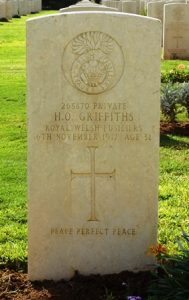
Matthew Hughes, Private, 241127, Royal Welsh Fusiliers. Matthew was born in 1894, the son of William Hughes and Margaret Hughes, of Nryn Llys Uchaf, Capel Curig. He worked as a farm labourer prior to the war. Matthew enlisted at Llanrwst into the 2/5th Battalion, Royal Welsh Fusiliers on 13 April 1915 and joined the battalion at Northampton, where it was attached to the 68th (2nd Welsh) Division. He was subsequently posted to the 1/5th Battalion, Royal Welsh Fusiliers, which was at Bedford attached to 158 Brigade, 53rd (Welsh) Division. On 19 July 1915 the entire Division sailed from Devonport for Imbros and on 9 August 1915 landed at Suvla Bay. The infantry moved off the beaches across the Salt Lake, under shellfire, into the scrub covered Chocolate Hill, but due to a lack of maps and no knowledge of the terrain, many of the units became disorientated, and the situation became chaotic. After the fighting died down, the winter rolled in, and the men first had to endure torrential downpours, which flooded the trenches, before the snow hit, and many men began falling ill in the terrible conditions. Matthew contracted enteritis and then paratyphoid during his time at Gallipoli and in November was invalided back to Britain aboard the Hospital Ship Aquitania. He embarked for France at the beginning of December 1916 and entrained for Marseilles, where he sailed for Alexandria, to re-join his battalion. The Division had just been evacuated from Gallipoli and had moved to Egypt to join the EEF, helping guard the Suez Canal before taking part in operations to drive the Turks out of the Sinai. The EEF then turned its attention onto driving the Turks out of Palestine, and on 26 March 1917 launched its first offensive against the coastal city of Gaza, which guarded the road to Jerusalem. Initial gains during the day were lost when the assaulting divisions lost touch with each other, and communication broke down when a thick fog cloaked the battlefield. Matthew was killed in action at some time during the day. The 22-year-old has no known grave and is commemorated on the Jerusalem Memorial, Israel.
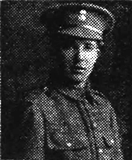
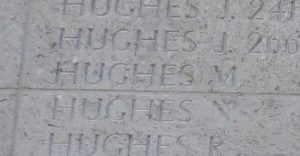
William Hughes, Private, 54616, Royal Welsh Fusiliers. William was born in 1890, the son of William Hughes and Ellen Hughes, of Tanyfron, Capel Curig. He worked as a slate quarrier prior to the war. William enlisted at Llanrwst into the Royal Welsh Fusiliers and was probably posted to Kinmel Park. He was drafted to France in the winter of 1916-17, and was initially posted to the 19th Battalion, Royal Welsh Fusiliers. The battalion had been raised in March 1915 by the Welsh National Executive Committee as a bantam Battalion, originally attached to the 38th (Welsh) Division, but in September 1915 moved to Aldershot to join 119 Brigade, 40th (Bantam) Division. Early in June 1916 the division moved to France, initially to positions around Lillers before taking over the North Maroc Sector, near Loos, for trench initiation and once acclimatised was left to hold the sector itself over the coming months. The infantry battalions of the Division then began the usual routines of rotating for duty in the trenches: normally four days in the front line; four in support and four in reserve. Late in 1916 the Division moved south to the Somme, and fought at the Battle of the Ancre, before remaining in the sector over the winter. In March 1917 the Germans withdrew to their shortened line, called the Hindenburg Line, and the 40th Division was among the units which followed the withdrawal. William took ill during this period and was evacuated to the base hospital at Wimereux, where he died of meningitis on 22 April 1917. The 26-year-old is buried in Wimereux Communal Cemetery, France.
Evan Jones, Private, 40686, York and Lancaster Regiment. Evan was born in 1897, the son of William Jones and Jane Jones, of Tan-y-Garth, Capel Curig. He enlisted at Llanrwst into the Royal Field Artillery on 11 December 1915 and was initially placed on the Army Reserve. Evan was mobilised on 6 October 1916, joining the Royal Field Artillery Depot at Preston, where he began his military training. Evan was soon posted to the 8th Reserve Battery, but upon being drafted to France on 7 January 1917, he was transferred to the 9th Battalion, York and Lancaster Regiment. Evan joined the battalion at Ypres, where it was attached to 70 Brigade, 23rd Division. Evan had not been at the front long when he was hospitalised with an abscess and soon after returning to duty was admitted to hospital again suffering from appendicitis. He returned to duty in time to take part in heavy fighting around Messines Ridge in May. The division then took part in the Battle of Messines Ridge on 7 June and remained in its new advanced positions for two weeks before being relieved. The division was training behind the lines when the Passchendaele offensive opened on 31 July, then at the end of August became placed in reserve to the 14th (Light) Division, before joining the offensive along the Menin Road. The division moved into the line on 15 September and at dawn on 20 September 1917 launched an assault to the north and south of the Menin Road, tasked with securing three lines. Evan was killed in action during the assault that day. The 20-year-old has no known grave and is commemorated on the Tyne Cot Memorial, Belgium.
Moses Llewelyn Jones, Lance Corporal, 39686, South Wales Borderers. Moses was born in 1885, the son of John Jones and Catherine Jones, of Helyg, Capel Curig. He was lodging at 29, Norton Street, Bootle, Merseyside by 1911 and was working there in a cotton warehouse. Early in 1916 Moses married Mary Jane Williams, of Frondirion, Garndolbenmaen, at Bootle. He enlisted at Bootle into the army, and was initially posted to the Royal Welsh Fusiliers, before being transferred to the Welsh Regiment. Upon being drafted to France in the winter of 1916-17, Moses was transferred to the 10th Battalion, South Wales Borderers, which was attached to 115 Brigade, 38th (Welsh) Division. The division had moved to Ypres after taking part in its epic assault on Mametz Wood in July 1916, taking over the Canal Bank sector at Boesinghe. The infantry battalions of the Division then began carrying out the normal pattern of rotation in the trenches, four days in the front, four in support and four in reserve, whilst also working on trench improvement, digging new trenches, and carrying out regular patrols and trench raids. On 31 July 1917 the Division launched its famous assault on the Pilckem Ridge, capturing Iron Cross and reaching its objective of the Steenbeek, then played a supporting role in the Battle of Langemarck. On 22 August the 10th SWB moved up from support positions at Au Bon Gite to support the 16th Welsh in front of the strongly held Eagle Trench, the Germans main line of defence in front of Langemarck. Moses was killed in action here on 27 August 1917, whilst the 10th SWB moved into positions on the right of the line to reinforce the 11th SWB. The 32-year-old has no known grave and is commemorated on the Tyne Cot Memorial, Belgium.
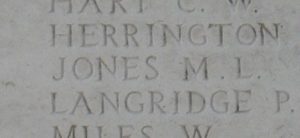
Thomas Alfred Oliver, Captain, Royal Flying Corps. Thomas was born at Loughborough on 10 April 1893, the son of Alfred Samuel Oliver, a renowned artist, and Annie Oliver (nee Kempson). The family had moved to The Studio, at Capel Curig by 1911. Thomas, himself a gifted artist, had enlisted as a private into the 6th Battalion, Royal Welsh Fusiliers at Carnarvon on 25 August 1914 but within three months was commissioned as Second Lieutenant and was posted to the 10th Battalion, Royal Welsh Fusiliers. Thomas then transferred from the Royal Welsh Fusiliers to the Royal Flying Corps in December 1915 after having gained his flying certificate at Shoreham on 17 October 1915. Early in 1916 Thomas was drafted to France and joined 1 Squadron, Royal Flying Corps, flying the Morane LA parasol reconnaissance aircraft. Thomas enjoyed one aerial victory in his Morane in July and saw his second victory whilst flying a Nieuport Scout in August. Early in 1917 he returned home on leave and upon his return was posted to 29 Squadron, Royal Flying Corps. He then shot down three more German aircraft in August 1917, whilst flying a Nieuport, making him an Ace. Thomas was on patrol over Belgium on 14 August 1917 when he was shot down and killed whilst flying a Nieuport 17, Serial B1557. The 22-year-old has no known grave and is commemorated on the Arras Flying Services Memorial, France.
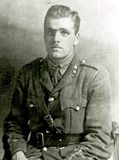
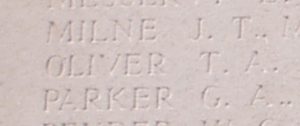
David Owen Roberts, Private, 241112, Royal Welsh Fusiliers. David was born on 29 September 1896, the illegitimate son of Jane Ellen Roberts and Thomas Williams. His mother raised him at 4, Bryn Llys, Capel Curig. David worked as a farm labourer prior to enlisting into the 2/5th Battalion, Royal Welsh Fusiliers at Llanrwst on 23 March 1915. The following month the battalion moved to Northampton to join 203 Brigade, 68th (Welsh) Division, before moving to Bedford in July. David embarked at Devonport aboard the HT Aragon on 8 October 1916 and disembarked at Alexandria twelve days later, before being posted to the 1/5th Battalion, Royal Welsh Fusiliers. The battalion was a Territorial unit, which was attached to 158 Brigade, 53rd (Welsh) Division, and had been in Egypt since being evacuated from Gallipoli a year earlier to join the EEF. The Division had helped guard the Suez Canal before taking part in operations to drive the Turks out of the Sinai. The EEF then turned its attention onto driving the Turks out of Palestine, and on 26 March 1917 launched its first offensive against the coastal city of Gaza, which guarded the road to Jerusalem. Initial gains during the day were lost when the assaulting divisions lost touch with each other, and communication broke down when a thick fog cloaked the battlefield. David was posted as wounded and missing during the fighting that day. No trace of the 22-year-old was ever found, so he was later deemed to have been killed in action on that date, 26 March 1917. He has no known grave and is commemorated on the Jerusalem Memorial, Israel.
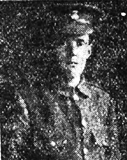
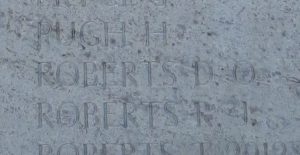
Glyn Roberts, Private, 15371, Royal Welsh Fusiliers. Glyn was born in 1892, the son of William Roberts and Kate Roberts (nee Pierce), of Glyn Llugwy, Capel Curig. After the death of William, Kate moved with her children to Plas-ym-Henllech, near Pwllheli, closer to her family. Glyn and his brother Llewelyn enlisted together at Pwllheli into the 10th Battalion, Royal Welsh Fusiliers soon after the outbreak of war. The battalion had formed at Wrexham in September 1914, joining 76 Brigade, 25th Division at Codford St. Mary, Salisbury Plain. In November 1914 the battalion moved to billets at Bournemouth, then at the end of April 1915 moved to Romsey before moving again to Aldershot to complete its training. The battalion landed at Boulogne on 27 September 1915 and the entire division moved to the Ypres Salient for trench initiation, before taking over the line at St. Eloi, near Ypres. The Division saw heavy fighting during the Actions of the Bluff in February 1916, following the German assault on the feature which saw several key positions lost. In an attempt to recapture these lost positions, 76 Brigade began to plan for a counterattack. The brigade moved into position and on 2 March 1916 launched its assault, recapturing The Bluff, before digging in. Glyn survived the initial assault, but was killed in action the following day, 3 March 1916, just prior to the 10th RWF being relieved from The Bluff trenches. The 23-year-old has no known grave and is commemorated on the Ypres (Menin Gate) Memorial, Belgium. Glyn is not commemorated on the Capel Curig war memorial.

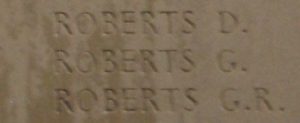
World War Two, 1939-1945
Llewelyn Price Davies, BEM, Petty Officer, D/SSX 19462, Royal Navy. Llewellyn was born at Pontllanfraith, near Newport, Monmouthshire on 9 July 1918, the son of John Ellis Davies and Margaret Davies (nee Jones). His father was from Capel Curig and his mother from Dolwyddelan. Llewellyn worked as a postman prior to the war. Llewelyn had married Mair Catherine Jones of Llanrug, and the couple had a son, Trevor, born in 1941. Llewelyn enlisted into the Royal Navy and was initially posted aboard the Flower-class corvette, HMS Borage. She had been launched on 22 November 1941 and completed on 29 April 1942, then after undergoing her sea trials she joined Western Approaches Command for anti-submarine warfare and convoy escort duties. She spent the coming months on escort duty for convoys on the North Atlantic, Gibraltar and South Atlantic routes. Llewelyn gained the award of the British Empire Medal on one such escort mission, when Borage rescued 33 survivors of the American tanker Robert H. Colley, which had broken in two in heavy seas, and later assisted the beleaguered cargo ship Empire Tarpon, subsequently taking part in the rescue of its crew. After being awarded his BEM by King George V at Buckingham Palace, Llewelyn was transferred to HM Motor Launch 222. On 16 August 1945, under strange circumstances, he reportedly committed suicide by shooting himself in the head. The 27-year-old was buried in Copenhagen (Bispebjerg) Cemetery, Denmark. His medals have recently been sold at auction.
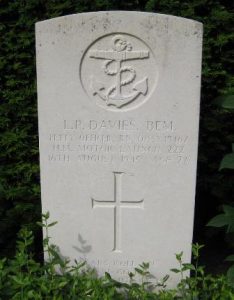
Ivor Stanley Hughes, Leading Aircraftman, 1657218, Royal Air Force Volunteer Reserve. Ivor was born in 1907, the son of Thomas Henry Hughes and Elizabeth Hughes (nee Sutcliffe), of Snowdon View, Capel Curig. He married Eulfwyn Walters, of Brynsiencyn, Anglesey, in 1941. Ivor enlisted into the Royal Air Force Volunteer Reserve and served throughout the war. After the surrender of Germany, the couple moved to The Rookery, Llanymynech, but Ivor remained in the Royal Air Force. He died at Liverpool Infirmary on 23 April 1947. The body of the 39-year-old was brought home and he was buried in Saint Curig and Saint Julitta’s Churchyard at Capel Curig. Ivor is not commemorated on the Capel Curig war memorial.
John Elwyn Owen, Sergeant, 1068297, Royal Air Force Volunteer Reserve. John was born on 10 September 1920, the son of Owen Robert Owen and Mary Olwen Owen, of Pont y Cynfyng, Capel Curig. He trained as a schoolteacher prior to the war. John enlisted into the Royal Air Force Volunteer Reserve and trained as a Flight Engineer before being posted to 9 Squadron, Royal Air Force, which was a heavy bomber unit, based at RAF Bardney. On the night of 3 July 1943, John took off from Bardney aboard an Avro Lancaster III, Serial ED689, which joined a large bomber force despatched to strike targets in Cologne. During the following morning, 4 July 1943, the Lancaster was shot down and crashed on the east bank of the Rhine at Koln-Poll in the City’s southeast suburbs, killing all seven of her crew. Twenty-two-year-old John and five of his fellow crewmen have no known grave, and are commemorated on the Runnymede Memorial, in Surrey, whilst two of the other crewmen’s bodies were later recovered and are buried in Rheinberg War Cemetery, in Germany.
